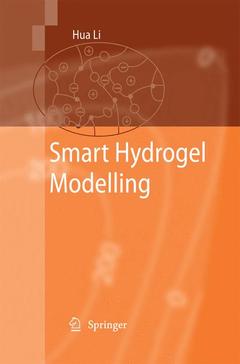Description
Smart Hydrogel Modelling, 2009
Author: Li Hua
Language: French
Subjects for Smart Hydrogel Modelling:
Smart Hydrogel Modelling
Publication date: 11-2014
359 p. · 15.5x23.5 cm · Paperback
Publication date: 11-2014
359 p. · 15.5x23.5 cm · Paperback
Approximative price 158.24 €
Subject to availability at the publisher.
Add to cart
Smart hydrogel modeling
Publication date: 10-2009
359 p. · 15.5x23.5 cm · Hardback
Publication date: 10-2009
359 p. · 15.5x23.5 cm · Hardback
Description
/li>Contents
/li>Comment
/li>
The science of mathematical modelling and numerical simulation is generally accepted as the third mode of scienti?c discovery (with the other two modes being experiment and analysis), making this ?eld an integral component of c- ting edge scienti?c and industrial research in most domains. This is especially so in advanced biomaterials such as polymeric hydrogels responsive to biostimuli for a wide range of potential BioMEMS applications, where multiphysics and mul- phase are common requirements. These environmental stimuli-responsive hydrogels are often known as smart hydrogels. In the published studies on the smart or stimu- responsive hydrogels, the literature search clearly indicates that the vast majority are experimental based. In particular, although there are a few published books on the smart hydrogels, none is involved in the modelling of smart hydrogels. For the few published journal papers that conducted mathematical modelling and numerical simulation, results were far from satisfactory, and showed signi?cant d- crepancies when compared with existing experimental data. This has resulted in ad hoc studies of these hydrogel materials mainly conducted by trial and error. This is a very time-consuming and inef?cient process, and certain aspects of fun- mental knowledge are often missed or overlooked, resulting in off-tangent research directions.
Chapter One Introduction 1.1 Definition and Applications of Hydrogel 1.2 Historical Development of Modelling Hydrogel 1.2.1 Steady-State Modeling for Equilibrium of Smart Hydrogels 1.2.1.1 Mathematical Models and Simulations 1.2.1.1.1 Thermodynamic Models 1.2.1.1.2 Transport Models 1.2.1.1.3 Multiphase Mixture Theory 1.2.1.1.4 Molecular Simulation 1.2.1.1.5 Remarks 1.2.1.2 Key Parameters in Steady-State Modeling for Equilibrium of Hydrogels 1.2.1.2.1 Hydrogel Composition 1.2.1.2.2 Preparation History 1.2.1.2.3 Electrolytes 1.2.1.2.4 Crosslinkers and Crosslink Density 1.2.1.2.5 Surfactants 1.2.1.2.6 Solvents 1.2.1.2.7 Metal Ions 1.2.1.2.8 Hydrogen Bonding Effect 1.2.1.2.9 Water State 1.2.2 Transient Modelling for Kinetics of Smart Hydrogels 1.2.2.1 Mathematical Models and Simulations 1.2.2.1.1 Phenomenal Model 1.2.2.1.2 Power Law Model 1.2.2.1.3 Multi-Field Model 1.2.2.2 Key Parameters in Transient Modeling for Kinetics of Hydrogels 1.2.2.2.1 Environmental Medium 1.2.2.2.2 Composition of Hydrogels 1.2.2.2.3 Salt 1.2.2.2.4 Crosslink Density 1.2.2.2.5 Diffusion Coefficient 1.2.3 A Theoretical Formalism for Diffusion Coupled with Large Deformation of Hydrogel 1.2.4 Remarks 1.3 About This Monograph Chapter Two Multi-Effect-Coupling pH-Stimulus (MECpH) Model for pH-Sensitive Hydrogel 2.1 Introduction 2.2 Development of the MECpH model 2.2.1 Electrochemical Formulation 2.2.1.1 Ionic Flux 2.2.1.2 Electrical Potential 2.2.1.3 Fixed Charge Group 2.2.2 Mechanical Formulation 2.3 Computational Domain, Boundary Condition and Numerical Implementation 2.4 Model Validation with Experiment 2.5 Parameter Studies by Steady-State Simulation for Equilibrium of Hydrogel 2.5.1 Influence of Initially Fixed Charge Density of Hydrogel 2.5.2 Influence of Young Modulus of Hydrogel 2.5.3 Influence of Initial Geometry of Hydrogel 2.5.4 Influence of Ionic Strength of Bath Solution 2.5.5 Influence of Multivalent Ionic Composition of Bath Solution 2.6 Remarks Chapter Three Multi-Effect-Coupling Electric-Stimulus (MECe) Model for Electric-Sensitive Hydrogels 3.1 Introduction 3.2 Development of the MECe model 3.2.1 Formulation of the MECe Governing Equations 3.2.2 Boundary and Initial Conditions 3.3 Steady-State Simulation for Equilibrium of Hydrogel 3.3.1 Numerical Implementation 3.3.2 Model Validation with Experiment 3.3.3 Parameter Studies 3.3.3.1 Influence of Externally Applied Electric Voltage 3.3.3.2 Influence of Initially Fixed Charge Density of Hydrogel 3.3.3.3 Influence of Concentration of Bath Solution 3.3.3.4 Influence of Ionic Valence of Bath Solution 3.4 Transient Simulation for Kinetics of Hydrogel 3.4.1 Numerical Implementation 3.4.2 Model Validation with Experiment 3.4.3 Parameter Studies 3.4.3.1 Variation of Electric Potential Distribution with time 3.4.3.2 Variation of Ionic Concentration Distribution with time 3.4.3.3 Variation of Hydrogel Displacement Distribution with time 3.4.3.4 Variation of Hydrogel Average Curvature with time 3.5 Remarks Chapter Four Multi-Effect-Coupling pH-Electric-stimuli (MECpHe) Model for Smart Hydrogel Responsive to pH-Electric Coupled Stimuli 4.1 Introduction 4.2 Development of the MECpHe model 4.3 Numerical Implementation 4.4 Model Validation with Experiment 4.5 Parameter Studies by Steady-State Simulation for Equilibrium of Hydrogel 4.5.1 Influence of solut
First book on the subject
Smart hydrogels are important new materials used in high tech and medicinal applications
Useful reference source with benchmark results to compare and verify experimental data
Includes supplementary material: sn.pub/extras
© 2024 LAVOISIER S.A.S.
These books may interest you

HydrogelsRecent Advances 168.79 €

HydrogelsRecent Advances 168.79 €

Smart Hydrogel Functional Materials 158.24 €

